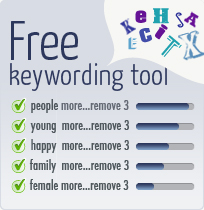 If you’ve ever wondered whether the smart money is on being exclusive or not, I have some interesting news. Turns out that the numbers are up up up on non-exclusive agencies, a trend I see continuing.
If you’ve ever wondered whether the smart money is on being exclusive or not, I have some interesting news. Turns out that the numbers are up up up on non-exclusive agencies, a trend I see continuing.
So why would anyone be exclusive?
Well, I must admit there are a few perks enjoyed by exclusives. First, being exclusive is just plain easier. You don’t have to upload again and again to a long list of different agencies or deal with all the hassle of using multiple interfaces. Throw in a higher commission and the possibility of gaining recognition or status on a site, and for some people this seems like a good option. So why am I not exclusive? Well…now that the hassle of uploading is over and I actually do have all my images online at all the these agencies, I really don’t mind the extra 0,90 USD RPI.
Consider future trends
 iStock, a special case
iStock, a special case
There’s no doubt that iStock is the biggest micro-agency in the world and that they really push exclusivity. They sweeten the pot with increased upload limits, easier uploading software, shorter inspection queues, higher payouts (up to double what non-exclusives make), promises that your exclusive gallery will get “increased attention from buyers”, but wait, there’s more… they’ll even throw in a box of personalized business cards.
One of my main problems with iStock is that as a non-exclusive, I am limited in the number of images I can upload. They really ought to consider the effect that policy has on their competitiveness in the industry. Photos that iStock turns away are happily snapped up by their competitors. This means that the bulk of images building up at other agencies is enormous.
If I’m a buyer and I want to see more images of one shoot or one model, the inventory at iStock can’t compete with what I’ll find on the other sites. And as a photographer I know that I should only upload my basic “sure things” to iStock, which means I reserve my more interesting and cutting edge work for other sites. The images iStock proudly presents on their Hotshots sheet of the week are unfortunately and ironically the same kind of niche images that they’ll never get from us non-exclusives who need to use our upload limit very carefully.



















Thanks Yuri…. I’ve always thought that non-exclusive had it better. I’m currently focusing on 9 agencies. I really don’t like iStocks policy on non-exclusive. I feel really left out. If you check all of Images of the Week, you’ll maybe find a hand full that are from non-exclusive members. And the rejection for improper keywording is not good!
The other day I posted an image in the forum to check before hand for copyright issues and I got told off for “pre-approving” images in the forum! If I’m allowed 15 images (I’m still bronze there) per week, I must make sure it wont get rejected for something I thought it would (it was a photo that showed part of a book). I’m glad to say the image was accepted anyway.
Anyway, back to the point! I think that what you do is the right way to go and I’m following your steps! Keep up the great work!
All the best,
Daniel Wiedemann
Very interesting and Educational as always Yuri.
Thanks for sharing your thoughts.
Regards Phill
Woh Great thinkings. Thanks
Thanks for that! Always wondered what your position on that was
Yuri, great article! Question… how long does it usually take you to upload your images to all the sites you currently submit to?
TO GARRY. I have four people + one supervisor that takes care of uploading my images. I guess it would be fair to say that it takes 5 full time individuals to manage my whole production. That’s 37,5×5 hours per week.
Wow!
Hi Yuri! I’m an exclusive contributor to iStock and I think that you hit the nail on the head with saying that it is a bit easier only uploading to just one site, and iStock is a good one to stick with. I think that if I had the amount of work you do and a staff to take care of it then I might go the same direction you do and be non-exclusive, but the way I do it works well for me. 🙂
BTW, thanks for sharing! You have some great info here on your blog.
Hi Yuri,
Thanks for the interesting post.
About the incomplete shoots that IStock gets from non-exclusives: sounds very reasonable, but I imagine the other side of the coin. They get some exclusive content (supposedly good) which cannot be found on any other site. Looks like in their opinion, this is more important…
To Nicole. Yes. Exclusivity works for single individual entities that produce less then 200 images per month. For more ambitious contributors non-exclusivity is great – but very time-consuming.
Hi Demid. The point here is that in a sense all the images that Istock never accept are in fact exclusive to the non-exclusive agencies. In series, with better search options. This gives Istock’s competitors a massive edge. This does not mean that Istock does not have a great collection of exclusive material, because they really do, it just means that so do the non-exclusive agencies as opposed to istock.
Great point about the unaccepted images effectively being exclusive to other sites, Yuri. I hadn’t thought about it that way before.
Hi Yuri,
What do you consider the top five – ten agencies to send to? Right now, sending to Dreamstime, they make it so easy but I’m about to cancel my non-exclusive arrangement with them.
Hail Rahul. Thank you for your comment. I was just about to send you an email. 🙂
In my opinion there is an intangible negative effect that in the long run will bite the micro-stock photographers in the butt which is that most people saturate the market with their images and upload the exact same photo’s everywhere they can.
This forces the sites to compete with each other for the same buyers to sell the exact same images which of course drives the price down. I don’t contribute to I-Stock but I admire their stance on rewarding loyal contributors. Those that upload their images to anyone that will take them should not be given prominent placement in the search engines in my opinion.
That’s just my .02 which is only worth about .0001 in American dollars right now 🙂
Mat
First off, cheers for an interesting read, where some really interesting points are made. But I’m curious about one thing, you mention that we’ll be able to negotiate prices, commissions etc. What makes you think that? It seems to me that people just takes what’s offered and doesn’t really think twice about it. Why do you think the big players involvement is going to change that?
ps. jeg haaber vejret er bedre i Danmark end det er her ovre i London, hvor det ikke bliver til megen udendoers fotografering for tiden 🙁
Hi Yuri just found this and you have so echoed my views on Exclusivity. And yes must admit I was getting so fed up with iStocks constant ‘Go Exclusive’ drive and it’s attitude towards Independent contributers, did not begrudge the perks for Exclusives as goodness knows they deserve something extra for giving up their freedom however I was becoming increasingly disillusioned with my more creative Images/concepts with a proven selling track record being met with the dreaded ‘over filtered’ email not to mention the way the search results were so biased against independents files….
Lets face it few views = few sales leaving you to rely on customers returning to ones Portfolio once they found something they liked. Was lucky and surprised to appear on the very first Hot Shot page but a Gal can only live off that for so long lol Think things have got better there lately with a more level playing field 😉
Sue
Hi Yuri !
Let me throw another argument into the discussion – Loyalty …
I worked many years as a publicity photographer and from time to time I had the idea to put some images of my “private” work into some imagebanks – In these times – 1990’s – all was still made with diapositives and for a “normal” photographer it was nearly impossible to get a foot into that business. Then the digital area and iStockphoto came up.
Suddenly I had an access to clients I never had imagined – Thanks to that great guy called Bruce Livingstone 😉
I thought about loading up my portfolio into different places and not going to be exclusive on iStock – but one big issue was my laziness to do all that stuff many times – having different ways to upload – to get your money – to control your portfolio …
So I went exclusive – The final reason was also because I wanted to show this kind of loyalty to the company which gave me this unique opportunity to get into this market and made it possible for me to live this great and funny experience which I would never have imagined a few years ago !
Greetings to Denmark
Great blog Yuri. Afters several years in film, I am now going back to photography try to make some money from microstock. I have started shooting in my studio, and have a couple of hundred pics with releases and everything. I´ll try to submit pictures next week, and I have one question that seems very difficult for me:
how do you keep track of your pictures? If you submit the same or similar pics to different agencies, what do you do to know which ones have been submitted and where…
I really hope there is some smart way of doing this, or else I´ll be totally swamped in paperwork…
Thanks again for sharing your work and experience with us all. Peter Gaszynski from Stockholm, Sweden.
Very interesting read, Yuri!
My own way is to become exclusive at iStock for the period of initial growth of portfolio. With small portfolio one has almost nothing to earn at most microstock sites. Again non-exclusives with small canister level (and portfolio) have very low upload limit at istock. So it is istock exclusivity for me at first and non-exclusivity after.
I love your designs and am plainnng to have a redo for my main blog…..I want to have it by Feb 14th , my one year ann…just have to decide what I want….any suggestions…
It’s posts like this that make surfing so much plurseae